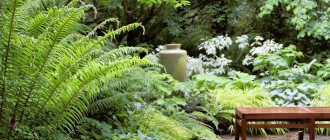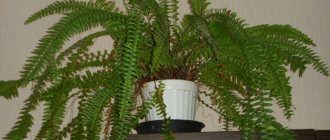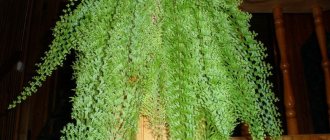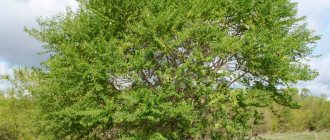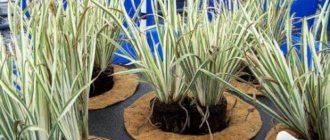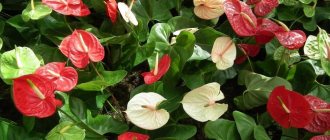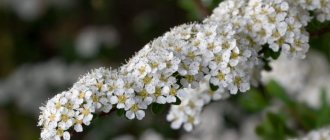Ferns are the most numerous division of higher spore-bearing vascular plants. These are the oldest inhabitants of our planet. No matter how much the climate on Earth has changed, among the huge number of plant species, only ferns have been able to adapt. They have survived to this day, growing in all climatic zones and striking in their diversity. People have long treated ferns in a special way, distinguishing them from other plants. Relict plants of the Mesozoic era, contemporaries of dinosaurs, living fossils - all this can be said about ferns.
Fern - a perennial herbaceous plant from the family of true ferns - has a strong, obliquely growing rhizome with an aboveground stem up to 1 m thick. The rhizome bears a bunch of pinnately dissected leaves. On their lower part there are clusters of sporangia (soruses). Ferns (Polypodiophyta) belong to the oldest groups of higher plants. Ferns belong to the Fern division; there are approximately 12 thousand species of them. In indoor floriculture, in accordance with the accepted systematization, ferns belong to the group of decorative leaf plants.
POTTED FENS
Many decorative species of ferns belong to different classes, orders, and families. Ferns are very widespread; in fact, they grow all over the globe and are found in a wide variety of places. But the greatest diversity of these plants is observed in tropical rainforests. The most commonly grown potted ferns are:
- Adiantum capillus veneris;
- Asplenium bulbiferum;
- Nephrolepis exaltata;
- Golden polypodium (Polypodium aureum);
- Platycerium alcicorr
In literature
The fern flower is found in folk tales, legends and songs.
A number of writers and poets have encountered the legend:
- Nikolai Vasilyevich Gogol (story “The Evening on the Eve of Ivan Kupala”);
- Józef Kraszewski (Fern Flower);
- Vincent Dunin-Martsinkevich, Yanka Kupala (“Kupala Night, Kurgan”);
- Yakub Kolas (“The Night When the Fern Blooms”);
- Mikhas Charot (Su Kupala");
- Frantisek Alekhnovich (children's play “Fern Flower”, 1916),
- Constance Billeaud (fern flower);
- Vladimir Korotkevich (“That Night”, reading “The Cradle of Four Witches”).
INTERESTING ABOUT FERNES
The fern itself, due to its physical, biological and chemical composition, is considered a genuine treasure. Fern shoots and rhizomes are used for medicinal purposes. Fern has been used for medicinal purposes since ancient times. The properties of the fern were described by Dioscorides, Pliny, Avicenna and others. According to its chemical and biological composition, the fern belongs to radioprotector plants, healers and elixirs. It contains 18 valuable amino acids: fructose, sucrose, glucose, arabinose, fiber, ash, protein and amine nitrogen, 40% starch, alkaloids, essential oils, tannins and orec-tannic acid.
Scientists have discovered a species of fern that grows well even in the presence of high concentrations of arsenic in the soil. They suggested that this plant, namely Pteris vittata, could be used to cleanse land and water from THIS TOXIC element or its compounds. Scientists have proposed passing water through reservoirs seeded with this type of fern to cleanse it of arsenic.
Most likely, everyone, without exception, is well aware of the story that once a year on Ivan Kupala, on the shortest night of the year, in a deep forest, under a birch tree with three trunks from one root, a fern blooms. Its flower glows like a flame. If you find this flower, you will have good luck in any matter. And the fern flower is protected by its evil spirits, which does not allow it to be taken out of the forest. Unfortunately, this, although beautiful, is just a legend. Ferns do not bloom , but reproduce by spores.
On the underside of the leaves of most ferns there are special structures called sori, which contain sporangia - organs that form spores. And in some types of ferns, spores are located on special modified leaves.
General description of fern-like plants
There are several versions about what a fern is. The scientific community ranks it among the oldest plants - rhinophytes. In the process of evolution, the structure of the fern has become more complex, which is why the fern is classified as a higher plant.
Fern cannot be confused with any other plant
Several facts that support this opinion:
- The plant develops in cycles.
- There is a developed vascular system.
- The bushes are distinguished by their good ability to adapt to the way they live on land.
Representatives of ferns are perennial shrubs belonging to the spore family. However, many gardeners are still concerned about the question: is a fern a shrub or a herb? Both answers are positive.
Interesting! There are plants so tall that they are considered trees.
Ferns come in a variety of colors and colors. Therefore, each plant is beautiful in its own way and certainly decorates the place where it grows. These unusual shrubs are often used in landscape design and home interiors. They practically do not get sick with proper care.
The plant has the appearance of an evergreen shrub and does not bloom. However, for the Slavs this flower was and remains a symbol of love and happiness. There is a tradition to look for it on the night of Ivan Kupala.
Biological classification of ferns
The classification of ferns is quite complex due to the large number of species. Scientists have long attempted to build a system. There were trial designs that differed from each other. And only much later did a unified classification emerge, based on the structure of the reproductive organ (sporangium) and some other characteristics.
Briefly, all plants are divided into 2 groups: ancient and modern. The department of ferns consists of 7 classes of extinct and currently existing vascular plants. These classes are briefly presented below:
- the oldest and simplest group in structure is Aneurophytopsida;
- an ancient representative similar in appearance to conifers - Archaeopteridopsida;
- “blind evolutionary branch” - this is the nickname of Cladoxylopsida;
- the transitional category to contemporaries is represented by Zygopteridopsida or Goenopteridopsida;
- modern plants - Ophioglossopsida or grasshoppers (Ophioglossopsida);
- large and compact perennials - Marattiopsida;
- yet another contemporaries, among which perennials are more common and annuals are less common - Polypodiopsida.
The latter are divided into 3 subclasses: Polypodiidae, Marsileidae, Salviniidae.
Transitional class of ferns
TYPES OF FERNES AND PLACES OF GROWING
When we hear the word “fern,” most of us imagine a pot of unattractive grass. But few people know that ferns have populated all continents, except, of course, Antarctica, and they feel great in any conditions.
Tree-like giant ferns, liana ferns, and epiphytic ferns grow in tropical forests. Epiphytes are plants that grow on other plants, mainly on tree branches and trunks, as well as on leaves (epiphylls), and obtain the necessary nutrients from the environment, but not from the host plant. That is, in no case should one confuse epiphytic plants and parasitic plants. In the process of evolution, some epiphytes have developed special adaptations for capturing water and minerals from the air. These are, for example, spongy covers on the roots, or so-called root nests - plexuses of roots in the form of a basket in which dust and fallen leaves accumulate and thus create soil for feeding roots. A similar adaptation is found in the Asplenium fern . Other epiphytes, such as the Platicerium fern , have so-called niche leaves that form a niche on the trunk in which soil is also created.
Asplenium nidus
There are giant ferns, for example, Asplenium nidus. This plant is a typical epiphyte, native to tropical Asia. Ferns grow on the trunks of large trees. Reaching enormous sizes (diameter - several meters, and weight - up to a ton or more), asplenium breaks even gigantic trees with its weight. We know aspleniums as ordinary indoor plants, whose sizes are much more modest.
Among ferns there are species that live under water, for example, Marsilea quadrifolia . This fern is often used to decorate small ponds on the site, as the appearance is very decorative.
marsilea quadrifolia
Salviniaceae family is most famous here . These plants can be called weeds of tropical rivers. Reproducing in huge quantities, salvinia becomes an obstacle to water transport, interferes with the normal operation of hydroelectric power stations, and clogs fishing nets.
Salviniaceae
Azola caroliniana
Another floating fern is Azol a caroliniana , grown in rice fields. This plant has a unique ability to accumulate nitrogen, in addition, Azola suppresses the growth of weeds in rice plantations.
Among the ferns, there are dwarf ferns that are only a few millimeters long. These microscopic plants grow in tropical forests on the surface of stones or the ground, rising to a small height along tree trunks. Among the ferns there are real “trees” - the genus Cyathea , whose height reaches 25 meters, and the trunk diameter reaches half a meter.
Fern genus Cyathea
There are ferns whose leaf petioles can rival steel in strength - Dicranopteris . You can get through the thickets of Dicranopteris only by working hard with a machete, on the blade of which the fern leaves marks, as if cutting real metal wire.
Dicranopteris
Growing ferns indoors became fashionable in the 18th century. At that time, ferns could be seen in elite English salons; they were decorations of expensive hotels and houses of noble people. However, only a few species were grown as ordinary houseplants, because gas combustion products and smoke from coal, which was then used for heating, are extremely poisonous to almost all ferns. Then the British came up with special “fern showcases” (glass boxes framed with cast iron) for ferns, which maintained the necessary air and soil humidity.
Flower growers became interested in ferns at the beginning of the 19th century. In Europe, they planted gardens and parks and decorated picturesque shady corners near water bodies. Currently, ferns are highly valued by both professional and amateur gardeners all over the world. For example, in Germany there is a whole network of greenhouses that specialize exclusively in the cultivation and sale of ferns, the leaves of which are then used in making bouquets and various flower arrangements.
It is believed that more than two thousand species of ferns are now suitable for growing indoors. But despite this, resistant cultures of more than four hundred species of ferns have been bred in greenhouses and greenhouses of botanical gardens.
There is no consensus among professionals as to whether these plants are difficult or easy to grow. But one thing is for sure: ferns require constant care.
Interesting properties
In popular belief, this plant has magical properties.
Since time immemorial, it has been used not only for magical rituals, but also for the treatment of many diseases:
- With the help of a flower obtained at midnight before Ivan Kupala, you can find treasures.
- To attract the groom , the girl weaves a branch of fern into her braids and wears him like that.
- To get rid of pain during radiculitis , you need to fill the mattress with leaves and branches of fern. The healing book claims that pain and inflammation will quickly go away.
- The root of this plant is used in magic against the evil eye. To do this, the crushed part of the root is added to various potions. Anyone who drinks this decoction will get rid of diseases caused by the “evil eye.” It can protect against diseases. The root helps with love spells and lapels, and removes the effect of any ritual that the person did not agree to perform.
- If you place a whole fern root over your home, it will protect the inhabitants of the house from negative energy. A sorcerer and any person with evil intentions cannot enter such a dwelling.
- To use fern as a reliable remedy for the evil eye , you should wear it as close to your body as possible. To do this, the fern is dug up at dawn, washed, and placed in the sun to dry. It should be applied the next day.
- The root is used for gypsies . The plant helps to maintain clarity of thought and will not allow a person to deceive himself when communicating with her.
Some peoples use fern for pickling. Prepared products with fern added to the brine have very interesting taste qualities.
STRUCTURE OF FENS
Ferns (Polypodiophyta) are a division of higher plants occupying an intermediate position between rhinophytes and gymnosperms. Ferns differ from rhiniophytes mainly by the presence of roots and leaves, and from gymnosperms - by the absence of villages. Ferns originated from rhiniophytes, to which the oldest Devonian ferns were very close. Some of the most primitive genera were intermediate forms between rhyniophytes and typical ferns). Ferns, like other higher plants, are characterized by an alternation of generations - asexual (sporophyte) and sexual (gameophyte), with the dominance of the asexual generation.
Fern sporophyte is a herbaceous or tree-like plant, mostly with large, repeatedly dissected leaves (young leaves are usually snail-shaped). Ferns are characterized by a wide variety of shapes, internal structures and sizes. Their leaves vary from multiple pinnately dissected to whole, from gigantic - 5-6 m long (in some representatives of Marattia and Cyathea) and even up to 30 m (curly leaves in Lygodiu articulatum) to tiny leaves only 3-4 mm long, consisting of 1 layer cells (in Trichomanes goebelianu). The length of the stems of ferns varies from a few centimeters to 20-25 m (in some species of Cyathea). They are underground (rhizomes) and aboveground, erect and climbing, simple and branched. In most sporangia are located on ordinary green leaves; some leaves are differentiated into spore-bearing (sporophylls) and vegetative, green.
Most ferns are homosporous. Among modern ferns, only three small families of aquatic ferns are heterosporous: Marsileaaceae, Salviniaceae and Azollaceae.
Comparison with other herbaceous plants
Pteridophytes include ferns, club mosses, and horsetails. They have the same origin, and they all multiply through the formation of spores. However, ferns also have distinctive properties from herbaceous ones:
- the root system and complex structure of the leaves differ from algae;
- the predominance of the sporophyte in generations, in contrast to mosses, which, as a rule, have a gametophyte in generations;
- the presence of tissues capable of conducting water;
- lack of flowering.
Fern is an ancient, beautiful plant that will decorate both the garden plot and the interior of the apartment. Its chemical composition is endowed with medicinal properties, which is used in medicine. There are varieties suitable for consumption.

